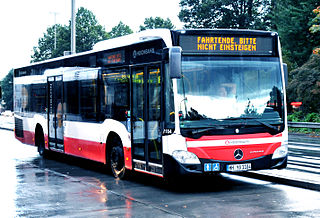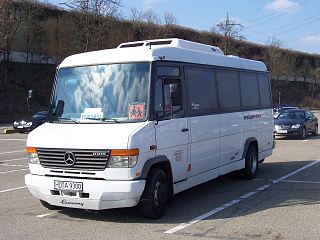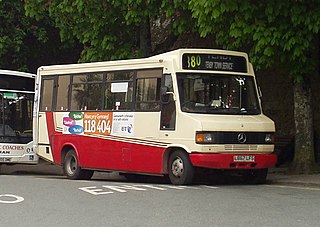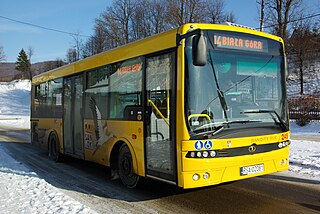
The Unimog is a range of multi-purpose tractors, trucks and lorries that has been produced by Boehringer from 1948 until 1951, and by Daimler Truck since 1951.

The Mercedes-Benz Sprinter is a light commercial vehicle (van) built by Mercedes-Benz Group AG of Stuttgart, Germany as a large van, chassis cab, minibus, and pickup truck. In the past, the Sprinter had been sold under the Mercedes-Benz, Dodge, and Freightliner nameplates. In the U.S., it was built from complete knock down (CKD) kits by Freightliner. Re-badged and re-engined Sprinters were also sold by Volkswagen Commercial Vehicles as the Volkswagen LT and the Volkswagen Crafter. They are now primarily marketed by Mercedes-Benz.

A minibus, microbus, minicoach, or commuter is a passenger-carrying motor vehicle that is designed to carry more people than a multi-purpose vehicle or minivan, but fewer people than a full-size bus. In the United Kingdom, the word "minibus" is used to describe any full-sized passenger-carrying van or panel truck. Minibuses have a seating capacity of between 12 and 30 seats. Larger minibuses may be called midibuses. Minibuses are typically front engine step-in vehicles, although low floor minibuses are particularly common in Japan.

Mercedes-Benz has been producing buses since 1895 in Mannheim in Germany. Since 1995 Mercedes-Benz buses and coaches is a brand of EvoBus GmbH, a wholly owned subsidiary of Daimler Truck.

Active Body Control, or ABC, is the Mercedes-Benz brand name used to describe electronically controlled hydropneumatic suspension.

The Mercedes-Benz Atego is a range of general-purpose rigid trucks introduced by Daimler Truck in 1998. A new model was introduced in 2004, followed by a facelift in 2010 and another new model in 2013. The latest version is available in gross vehicle weights of 6.5 to 16 tonnes (t) and is powered by a straight 4- or 6-cylinder engine.

A midibus is a classification of single-decker minibuses which are generally larger than a traditional minibus but smaller than a full-size single decker and can be anywhere between 8 metres and 11 metres long. While used in many parts of the world, the midibus is perhaps most common in the United Kingdom, where operators have found them more economical, and to have a sufficient number of seats compared to full size single-decker buses.

The Mercedes-Benz Vario is a full-size commercial heavy van and medium duty truck manufactured by Mercedes-Benz between 1996 and 2013.

Autosan Sp. z o.o. is a Polish bus and coach manufacturer. The company is located in Sanok, Poland. Its sales network includes European, African and Asian countries. Currently it produces approximately 300 buses a year.
The Mercedes-Benz MB100 is a light commercial cabover van (M) made by Mercedes-Benz España S.A. from 1981 to 1996 at their Vitoria-Gasteiz factory in northern Spain. The third generation model was manufactured by SsangYong alongside the rebadged SsangYong version from 1995 to December 2003 in South Korea, with another rebadged variant manufactured by Maxus of SAIC Motor from 2009 to 2014 in China.

The Mercedes-Benz T2 is a semi-bonneted light commercial vehicle that was manufactured by Daimler-Benz. The T2 is also known as the "Düsseldorf Transporter", since it was built in Düsseldorf from 1967 to 1991. The third generation, built from 1996 at Ludwigsfelde, was branded the Mercedes-Benz Vario.

The Plaxton Beaver, originally known as the Reeve Burgess Beaver, is a minibus body built by Plaxton. It was built at the Pilsley, Derbyshire factory of Plaxton's Reeve Burgess subsidiary from 1987 to 1991, at Plaxton's main Scarborough factory from 1991, and from 1995 at Anston in South Yorkshire.
Indcar is the trading name of Industrial Carrocera Arbuciense SA, a Spanish-based coachbuilder, specialized in building mini- and midibus bodies mainly on Mercedes-Benz, Iveco and Man vans and truck chassis. Their products are sold throughout all of Western Europe.
AMZ Kutno is an automotive company based in Kutno, Poland, that has been operating since 1999. It specializes in the design and manufacture of special bodies for commercial vehicles, such as minibuses, ambulances, security vans and special vehicles for the uniformed services. The company also produces a line of city buses and various military vehicles.

Astra Bus is a bus manufacturer based in Arad, Romania. The company was established in 1996, splitting from Astra Vagoane Arad, a company specialized in manufacturing railroad cars. Since 2003, it is part of the Cefin Holding Group and their products have been buses and trolleybuses from the Irisbus range, under a partnership with the Italian company, and, on a small scale, minibuses based on Iveco, Mercedes-Benz or Volkswagen chassis.

C&I Eurotrans XXI is a coachbuilder based in Bucharest, Romania. The company was established in 2002, and it is specialized in manufacturing coachwork for minibuses based on chassis from a series of other manufacturers.

The Autosan A0808MN Sancity is a low-entry city bus produced from the autumn of 2008 to mid-2009 in Sanok in Poland by Autosan. Its predecessor was the Jelcz M083C Libero which had an Autosan chassis, and successors are Autosan M09LE Sancity and Sancity 9LE. A0808MN Sancity and which are designed for urban and suburban public transportation services.

The Hanomag F-series is a series of medium-duty trucks built by Hanomag, then Hanomag-Henschel after a 1969 merger with the Henschel company, in their Bremen Seebaldsbrück plant from 1967 until 1973. It was replaced in favor of the more conservative Mercedes-Benz T2 after that company took over Hanomag-Henschel. The F-series badge was also used on the smaller "Harburger Transporter" as well as on some rebadged Mercedes-Benz T2 models.
Mellor Coachcraft, known simply as Mellor or Mellor Bus, is a British bus manufacturer based in Rochdale, Greater Manchester. Founded in the 1960s, Mellor has primarily produced bodywork for various different minibus chassis throughout its history. Mellor is owned by parent company, Woodall Nicholson Group, alongside Treka Bus.

Mercedes-Benz Argentina S.A.U. is the Argentine subsidiary of international conglomerate Mercedes-Benz Group which produces and markets Mercedes-Benz utilitary vehicles in the country. The company was established in 1951 and has its assembly plant in Virrey del Pino, La Matanza Partido, where trucks and buses has been produced. Furthermore, MBA imports a wide range of luxury automobile models including sedans, SUVs, and AMG Performance cars.


















